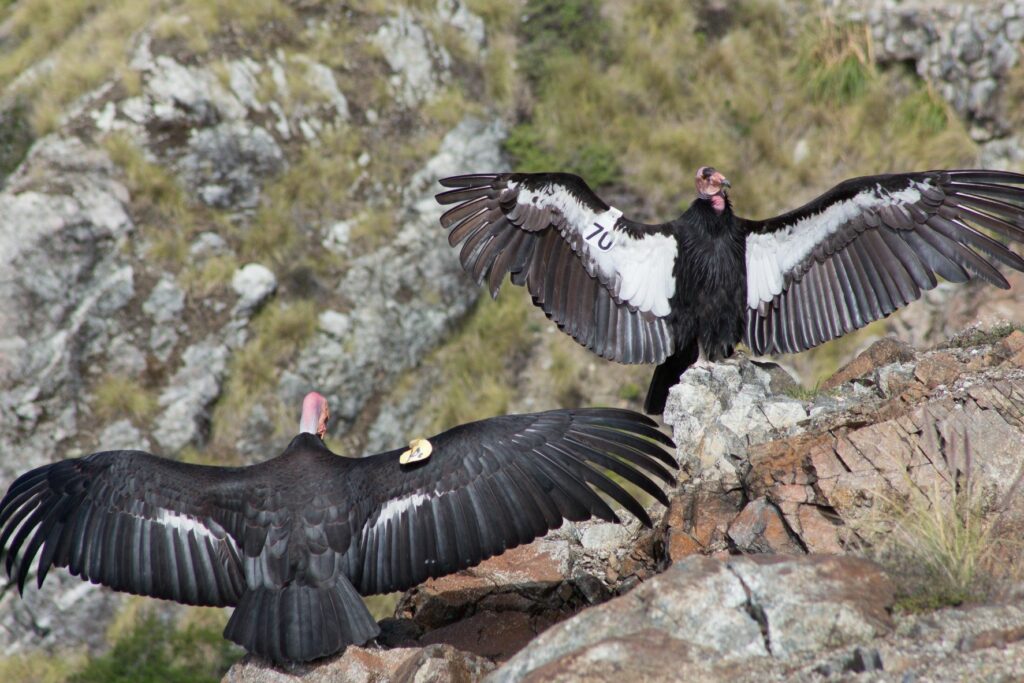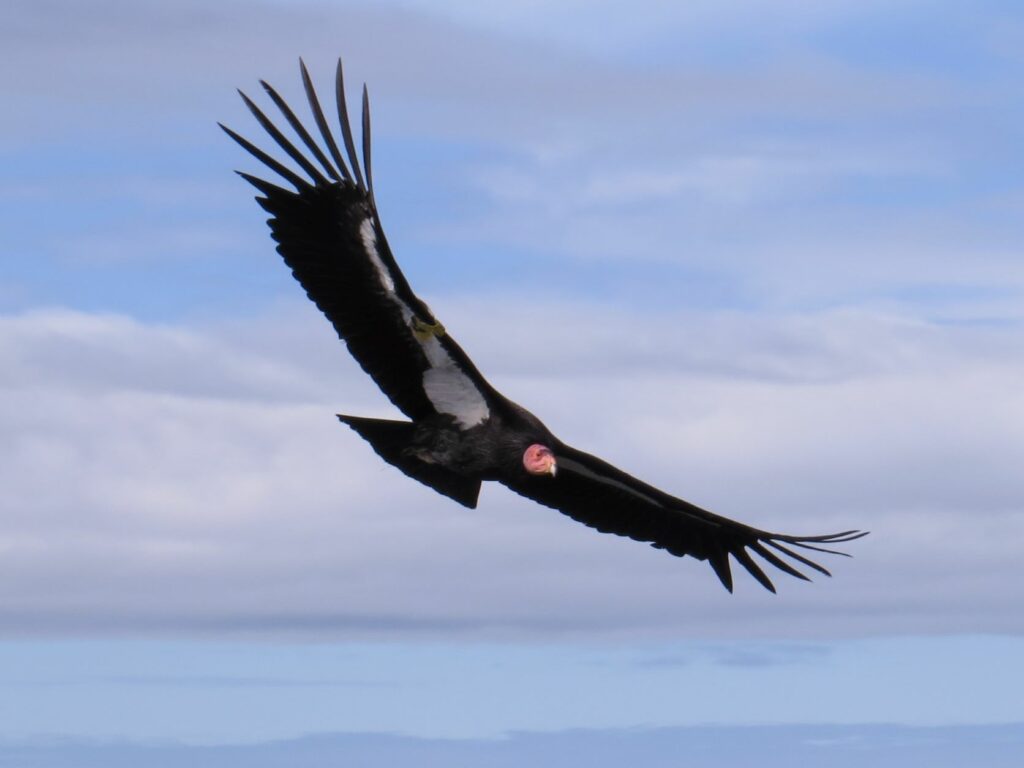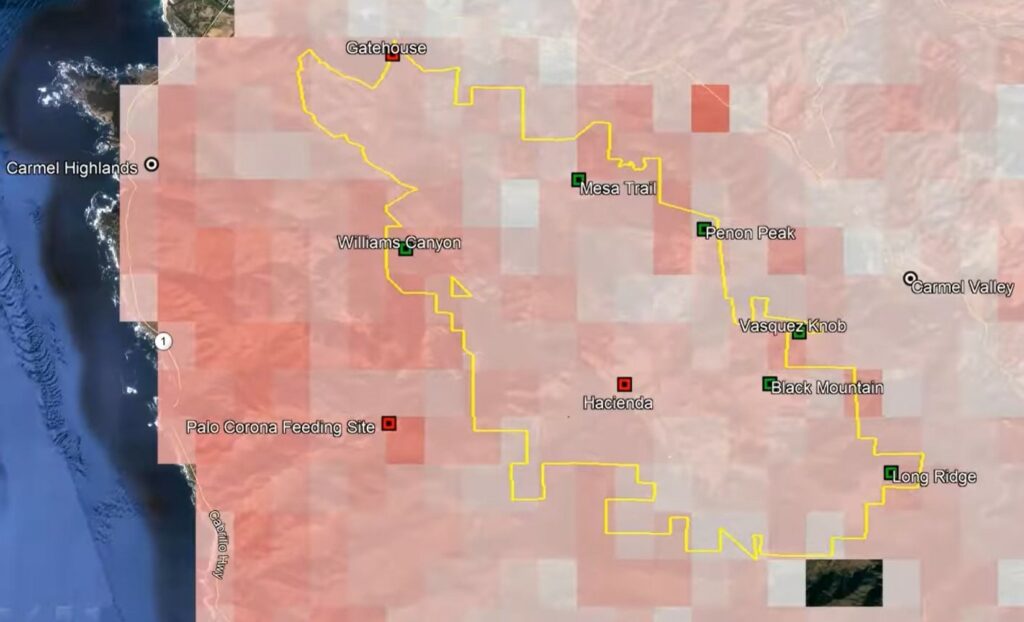
California Condors Tracked Soaring Over The Preserve
March 14, 2023
By Alix Soliman, Communications & Outreach Coordinator
The California condor (Gymnogyps californianus) is a critically endangered species that can be spotted soaring in the skies above with outstretched “fingers” in Pinnacles National Park and along the cliffs of Big Sur on California’s Central Coast. In 1982, there were just 21 condors left in the wild, limited to a small enclave in the mountains of Southern California. By 1987, there were no wild condors left, but 27 were kept in captivity to begin a captive breeding program with the hopes of releasing them back in the wild.
With the development of radiotelemetry, researchers were able to find deceased birds and complete autopsy reports. It became clear that condors were in precipitous decline due to lead poisoning. When a lead bullet pierces an animal, it shatters into hundreds of tiny fragments like glass. The condors find carcasses that have been shot and abandoned, unwittingly ingesting these slivers of lead that cause them to suffer excruciating deaths.
Through his work distributing free, non-lead ammunition to hunters and ranchers in condor country, Senior Wildlife Biologist at Ventana Wildlife Society Mike Stake has discovered that ranchers often shoot ground squirrels and leave the carcasses. “Many of the ranchers tell me that when they fire their gun, the condors actually come. Perhaps they’re associating this sound with an easy meal,” Mike said.
Condors can live to be about 60 years old, and they don’t begin breeding until they are about six. Once they start mating, they can only lay a single egg the size of an avocado every other year. It takes two months for the egg to hatch and six to eight months for the chick to leave the nest. The fledgling is then dependent on its parents for another year or more

“They don’t exactly breed like rabbits,” said Mike. This long life cycle makes recovery efforts a slow-going process, especially as the species continues to face man-made threats in the wild. Ventana Wildlife Society has been working on condor reintroduction on the Central Coast since 1997. Biologists equip condor wing tags with solar powered GPS transmitters that identify individual birds and send a GPS point to researchers every minute when the bird is in range of a cell tower. “This data helps us locate areas where condors might be feeding and are exposed to lead poisoning,” Mike said.
Do you think you’ve glimpsed a condor flying over The Preserve? You may be right. Over the years, a handful of condor sightings have been confirmed. According to a 2020 report, Ventana Wildlife Society collected 1,475 satellite GPS locations of California condors on The Santa Lucia Preserve between July 2003 and January 2020. Many of the 34 condors detected were simply passing through – typically entering over Williams Canyon and exiting at Long Ridge – but two individuals spent more time here, perching and roosting overnight. Condor #477, named Pheonix for miraculously surviving the 2008 Basin Complex Fire in Big Sur, was responsible for almost half of the GPS points. One other condor, #547, had more than 100 GPS points on The Preserve.

In 2014, Ventana Wildlife Society started a feeding site at Palo Corona Regional Park, which was discontinued after the 2016 Soberanes Fire prevented researchers from accessing it. More condors passed through The Preserve in 2015 than any other year as they made their way to and from the Palo Corona feeding site. Afterwards, these visitors mostly dispersed south towards the feeding site at San Simeon and east to Pinnacles National Park.
With concerted conservation efforts and gun owners transitioning away from lead ammunition, the California condor is making a slow comeback. Today, 557 California condors exist globally and 343 are living in the wild, with 90 in Central California.
The Santa Lucia Conservancy is proud to partner with the Ventana Wildlife Society on bird monitoring, research, and conservation. For more information about California condors and how you can support their recovery, please visit their website.